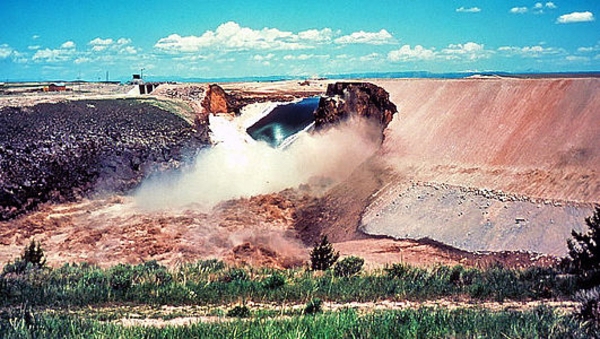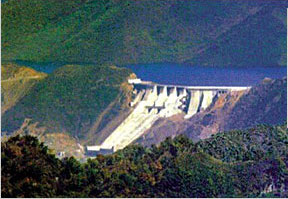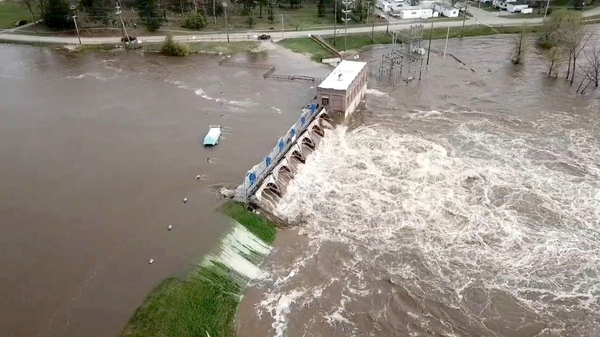I recently wrote about threats to dams in Syria (at "Syria's Looming Water Calamity") and Iraq (at "The Acute Danger of Iraqi Dams"); this topic raises the question of where and when dams have threatened those living downstream. Here are examples from outside Syria and Iraq, mostly intentional.
For quick reference, note these two Wikipedia entries: "Dam failure" and "List of hydroelectric power station failures."
(1) On October 2, 1574, the Dutch broke their dikes in the course of their war with Spanish troops. Lucas Joel explains:
In 1574, the city of Leiden in the Netherlands was brought to its knees: By August of that year, about 6,000 of the city's roughly 15,000 inhabitants had either starved to death, been killed by the Black Plague or had succumbed to dysentery. Plague doctors in their crow-beaked masks roamed the streets amid famished and diseased citizens drinking foul water from canals. No one knew when, if ever, help would come, for beyond Leiden's walls the Spanish army was laying siege and cutting off all supply routes into the city.
Leiden was at the very center of the Eighty Years' War, also known as the Dutch War of Independence, which had been raging since 1568 between the Spanish Empire and the provinces that today make up the Netherlands. The Dutch were fighting for their independence from Spain, and, in 1574, Leiden was the only thing preventing the Spanish from reaching and sacking two key Dutch cities to the southwest, Delft and The Hague. The whole revolution, it seemed, hinged on Leiden's survival.
At the time, the revolution's leader, Prince William of Orange, was elsewhere in Holland trying to raise an army, one that included the pirates and privateers known as the Sea Beggars, to help liberate Leiden. But the Spanish forces, led by Fernando Álvarez de Toledo, the Duke of Alva, were formidable. Orange's Sea Beggars could not reach Leiden as there were no navigable waterways between them and the city. Desperate, Orange gambled, deciding to break the North Sea dikes and allow the ocean to flood over the land — much of which is at or below sea level — in the hope of washing away the invaders. It was a long shot, but for Orange to repel Alva, and for the revolution to survive, it had to work.
And it did.
(2) In the beginning of World War I, on October 25, 1914, the Belgian Army opened the canal locks at Nieuwpoort, thereby flooding the Yser region of Flanders, ending the Battle of Yser, and halting the German army's advance through the course of the war. Here is a June 1915 account of "The Flooding of the Yser" by Belgium's Minister of Justice Carton De Wiart:
the Belgians, in this pitiless conflict, summoned to their aid a terrible and invincible assistant the inundation of low-lying lands. The canals in the valley of the Yser spilled their water into the fields. The water rose and streamed along the German trenches; while on the left bank, where the level of the soil was higher, the Belgians heroically defended their positions.
The Germans, threatened with death by drowning, rushed forward in a terrible offensive, seeking to break our lines, to conquer the dry land. In this unprecedented attempt they succeeded, on the 30th of October, in capturing one of our points of support, the village of Ramscappelle; but this essential position was immediately recaptured by two Belgian divisions and a few French battalions. This was the coup de grace.
On the 31st, decimated, dejected, defeated, the Germans abandoned their project of crossing the Yser; they retreated, abandoning guns and mortars engulfed in mire, enormous quantities of weapons, thousands of corpses, and many wounded.
(3) The worst civil engineering catastrophe in the United States in the twentieth century? The collapse of the St. Francis Dam, a 205-ft high concrete gravity-arch dam constructed by the City of Los Angeles that collapsed on March 12-13, 1928, killing at least
432 people.
(4) The 1938 breaching of Yellow River waterworks by the Chinese Nationalist forces fighting the Japanese invader has been called the "the largest act of environmental warfare in history." Here is the abstract of an article on the topic, "Drowned Earth: The Strategic Breaching of the Yellow River Dyke, 1938," Geoscience, November 1, 2009 pp. 287-297, by Diana Lary of the University of British Columbia:
Early in the war of resistance against Japan, the Chinese military command used a tragic version of scorched-earth tactics: they denied access to the Japanese imperial army to a vast stretch of China not by literally scorching it but by drowning it. In June 1938 the Chinese command turned the ultimate symbol of Chinese civilization, the Yellow River, into a weapon of war. The southern dyke of the River was breached at Huayuankou (Flower Garden Mouth) in Henan, 30 miles to the west of the Japanese vanguard. A cataclysmic flood swept through the breach, killing by the lowest estimate half a million people and turning millions of others into refugees.
The breach of the dyke was an attempt at strategic interdiction, to limit the mobility of the Japanese army and stop it moving further west. The waters of the River were to do what soldiers had not been able to do: to halt the Japanese advance. The breaching was a strategic move born of desperation. As the Japanese armies continued their relentless advance across China, sober strategic thinking in the Chinese command gave way to a mood close to panic, in which any conceivable action could be taken to stop the Japanese advance.
(5) In Operation Chastise, British war planes attacked and breached the Möhne and Edersee dams in Nazi Germany on May 16–17, 1943, using the famous "bouncing bomb" that avoided nets protecting the dams. The bombings led to flooding in the Ruhr and Eder valleys, two hydroelectric power stations destroyed, and the deaths of 1,600 civilians, among other damage.
(6) In an incident hushed-up by Mao's dictatorship, the Banquiao Dam, built in 1952, collapsed 23 years later. Here is an account by Eric Fish in International Rivers:
On the night of Aug 8, 1975, a line of people frantically piled sandbags atop Henan Province's Banqiao Dam while being battered by the worst storm ever recorded in the region. They were in a race with the rapidly rising Ru River to save the dam and the millions of people that lay sleeping downstream. It was a race they were about to lose.
Just after 1:00 am, the sky cleared and stars emerged from behind the storm clouds. There was an eerie calm as someone yelled, "The water level is going down! The flood is retreating!"
There was little chance to enjoy that calm. One survivor recalled that a few seconds later it "sounded like the sky was collapsing and the earth was cracking." The equivalent of 280,000 Olympic-sized swimming pools burst through the crumbling dam, taking with it entire towns and as many as 171,000 lives.
In addition, the collapse caused about 11 million people to become homeless.
(7) The Malpasset Dam, an arch dam on the Reyran River on the French Riviera collapsed on December 2, 1959, killing 423.
(8) The Teton Dam was an earthen dam on the Teton River in Idaho, United States. It was built by the Bureau of Reclamation, one of eight federal agencies authorized to construct dams. Located in the eastern part of the state, between Fremont and Madison counties, it suffered a catastrophic failure on June 5, 1976, as it was filling for the first time.
 The Teton Dam as the breach occurs. |
The collapse of the dam resulted in the deaths of 11 people and 13,000 cattle. The dam cost about $100 million to build, and the federal government paid over $300 million in claims related to its failure. Total damage estimates have ranged up to $2 billion. The dam has not been rebuilt.
 Imnam Dam in North Korea. |
(9, 10) A dam at the Vale corporation's Corrego do Feijao iron ore mine near Brumadinho, Brazil, released a wall of about 12 million cubic meters of iron ore tailings on Jan. 25, 2019. A week later, the mudflow's tally stood at 110 dead and 238 missing. Earlier, another Vale dam at Bento Rodrigues, Brazil, collapsed on Nov. 5, 2015, killing 19. (February 2, 2019)
(11) A Niobrara River dam at Spencer, Nebraska, broke. (March 14, 2019)
(12) Whaley Bridge, England: A pending dam disaster did not happen and the 1,500 persons evacuated have returned to their homes. (August 7, 2019)
Nov. 10, 2019 update: Aging dams are a serious hazard in the United States, the Associated Press reports:
A review of federal data and reports obtained under state open records laws identified 1,688 high-hazard dams rated in poor or unsatisfactory condition as of last year in 44 states and Puerto Rico. The actual number is almost certainly higher. ...
about 1,000 dams have failed over the past four decades, killing 34 people, according to Stanford University's National Performance of Dams Program. ...
[The Association of State Dam Safety Officials] estimates it would take more than $70 billion to repair and modernize the nation's more than 90,000 dams.
(13) Midland County, Michigan: In what is being called a once-in-500-years-event, two dams (Edenville and Sanford) collapsed on the Tittabawassee River due to record rainfall leading to the evacuation of about ten thousand residents of Midland. (May 20, 2020)
 The flooding at Michigan's Sanford Dam, May 19, 2020. |
May 23, 2020 update: The Midland County disaster has brought to public attention the federal government's National Inventory of Dams study finding that of the more than 91,000 dams in the United States, about 17 percent or 15,000 of them are classified as having high hazard potential, meaning the loss of human life is likely if the dam falls. Of those, some 2,300 dams are classified in poor or unsatisfactory condition.
(14) Ukraine: It appears that the Ukrainian resistance is flooding the country to hold back the Russian assault. (March 9, 2022)
June 27, 2022 update: Gordon G. Chang writes about the Three Gorges Dam in "Taiwan's Message for China: We Have a Nuke-Like Weapon":
The range of Taiwan's Yun Feng cruise missile has never been publicly confirmed, but analysts believe it to be about 1,240 miles, sufficient to reach both the Chinese capital and the Three Gorges Dam, the world's largest flood-control structure.
China's dam creates a reservoir of 39.3 billion cubic meters of water on the Yangtze River and is upstream from about 400 million people. Almost 30% of China's population, therefore, is at risk of a catastrophic failure of the structure, such as one caused by a missile strike. That means Taiwan possesses a conventional weapon that packs the wallop of a nuclear one.
(15) Ukraine: Russian forces caused a breach the Kakhovka Dam, which is in a part of Ukraine they have invaded and control, doing massive damage to people and property. (June 6, 2023
(16) Brazil: Heavy rain caused a breach in a dam in the state of Rio Grande do Sul, causing a 2-meter wave. (May 2, 2024)
(17) Zambia: A breach of a tailings dam on February 18 at the Sino-Metals Leach Zambia copper mine has had "catastrophic" environmental consequences, killing the vital Kafue River and causing a diplomatic crisis between Zambia and China. (March 24, 2025)